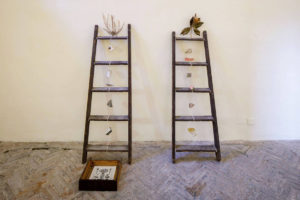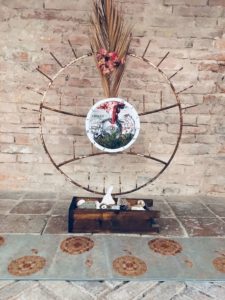For Paola Tassetti to make art is perhaps, above all, a soul making. A tireless and continuous journey between the present and the past, the culture and the nature, the mind and the body. A contemporary odyssey that explores and gives new shape to physical territories and mental landscapes.
The exhibition Iconema. Ipertrofie naturali, curated by Massimo Vitangeli at Spazio K, in Palazzo Ducale Urbino, significantly condenses the artist’s way of proceeding.
Entering in the great kitchen, the gaze is irresistibly captured by the swirling presence of the work Iconema. On the floor, in a concentric form, to recall the poetics of Dante’s circles, are mixed plant traces, mineral elements, anatomical objects and everyday life objects, plaster sculptures of Aphrodite, Eros and Pitino, fragments of the artist’s individual history. In the middle of the composition a uterus symbolies the act of fertilization and generation. Everything is scrupulously collected and found by Paola Tassetti in trips and wanderings up and down the peninsula. Like Telesforo, the etruscan god protector of the journey, she crosses forests and mountains, museums and archives, sea coasts and unknown places. These meticulous and scientific collections are the first acts that generate the work. An anatomical-vegetal twine, which proceeds in a mysterious circularity, able to condense the collective memory and the individual one, returning us an emotional psychogeography of the environment and the culture.
The Archivio mineralogico is composed of two old staircases of the 19th century and of a drawer that contains a table from 1774. The artist modifies the table and the stairs. The rocky sections on the paper take the form of male bone human members. An open flower springs from the central stone, like a source of life and fertilization. Inside the stairs we can see stones gathered between Trentino, Conero, Tuscany and the Sibillini Mountains. The mineral elements are joined together by triangulations created with the thread, which give the impression of a skeletal shape. At the top of the steps there are vegetal presences, always coming from the Harvest rituals that distinguish the artistic action of Paola Tassetti.
A triptych is then composed of three anatomical and botanical tables reworked. In the first, concerning the fecundation of monocotyledonic and dicotyledons flowers, the artist modifies the natural elements thanks to the insertion of eyes, ears, vaginas, tongues and cells. In the second, which treats the dissemination and the germination of fruits and seeds, a similar compositive scheme is used. This time, however, the anatomical grafts do not have a damp taste, but a calcified aspect. The fruits and seeds are intertwined with male bone members. There is a sweet and intelligent contrast between the acceptance of the feminine and the hardness of the masculine. The third table focuses almost exclusively on the eyes, the great architects of natural and artistic vision.
The canvas becomes a hymn to the tear apparatus and to the creative power that this organic dimension expresses and contains. The eyes, of the rest, are the great allies of the spirit here on Earth.
The work Privus Naturante catapults the gaze into a dreamlike and ancient, sensual and religious, anatomical and vegetal space. A man sits on a stone, in the background an arch and archaic remains. The human face of the figure has left the place to a floral explosion with red, green and white colors. Also the venous apparatus has undergone some changes, now it resembles a vegetal, ruby and gaudy lymphatic system. In the right hand the skull of vanitas turns into a white white flower. The horror vacui, coming from meditation on death, gives way to the contemplation of a flowering, source of life. The canvas is supported by a metal structure, found in a former mental hospital. At the top a reversed ampoule, from which drips the natural and magical potion that gives new life and shape to the man of the painting, contemporary alchemy. On the floor, wonderful pink flowers are gently laid down to remind us that the heart and soul can bloom in every time and place.
The exhibition closes its circle with an installation with a mystical and religious tone, inside the fireplace: Humanus Fumus. An ancient rusty iron structure contains a circular composition. A big eye is immersed in the green grass. From the top of the eyeball comes a reddish smoke, that brokes the serenity of the vision. Perhaps the world is on the brink of collapse? Perhaps only beauty without reserve can save it? Above the eye a dry palm leaf with pink flowers in the middle.
On the floor a wooden drawer contains white and grey stones. A finely decorated Japanese mat invites us to kneel, as in a rite, to contemplate and dream the resilient and liberating stength of the Anima Mundi that Paola Tassetti tells and unfolds.
Info:
I C O N E M A
Rassegna – Il Tempo Dello Sguardo
curated by Massimo Vitangeli – Peter Aufreiter
Paola Tassetti
5 September – 13 October 2019 (Grande Cucina Palazzo Ducale Urbino) SPAZIO K
 Paola Tassetti, Archivio Mineralogico Ossarile, 2019 Legno Roccia Herbarium Ph. Wilson Santinelli
Paola Tassetti, Archivio Mineralogico Ossarile, 2019 Legno Roccia Herbarium Ph. Wilson Santinelli
![]() Paola Tassetti, Iconema, 2019. Reliquario psicogeografico Diametro installazione 6M Oggetti prelevati dalla realtà ampolle urne cofanetti vetro piante essiccate anatomia gomma gesso archivi vegetali Ph. Paola Tassetti
Paola Tassetti, Iconema, 2019. Reliquario psicogeografico Diametro installazione 6M Oggetti prelevati dalla realtà ampolle urne cofanetti vetro piante essiccate anatomia gomma gesso archivi vegetali Ph. Paola Tassetti
 Paola Tassetti, Trittico. Studi di Microbiologia Anatomica, 2019 85×120 Ph. Paola Tassetti
Paola Tassetti, Trittico. Studi di Microbiologia Anatomica, 2019 85×120 Ph. Paola Tassetti
 Paola Tassetti, hūmānus fūmus – the human condition. EMBLEM X 2019 Canvas Ferro Legno Roccia
Paola Tassetti, hūmānus fūmus – the human condition. EMBLEM X 2019 Canvas Ferro Legno Roccia

Andrea Grotteschi (1987) lives and works between Lake Maggiore and Milan. He graduated in Aesthetics at the University of Milan in 2013. After his studies he began his curatorial activity in the field of contemporary art and culture, collaborating in particular with the cultural association Asilo Bianco. He has curated public cultural and exhibition projects, such as Studi Aperti Arts Festival (2015, 2016) and Sor’riso Amaro. Work and the paddy field, contemporary visions (2017). Since 2018 he works as an independent curator and critic.






NO COMMENT